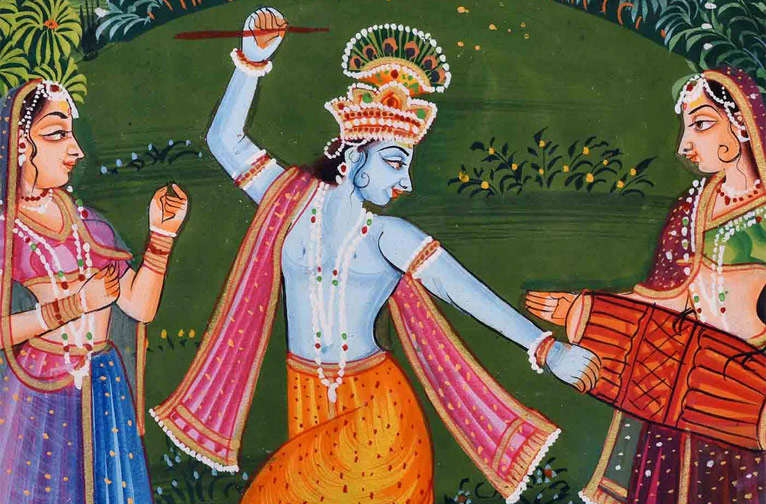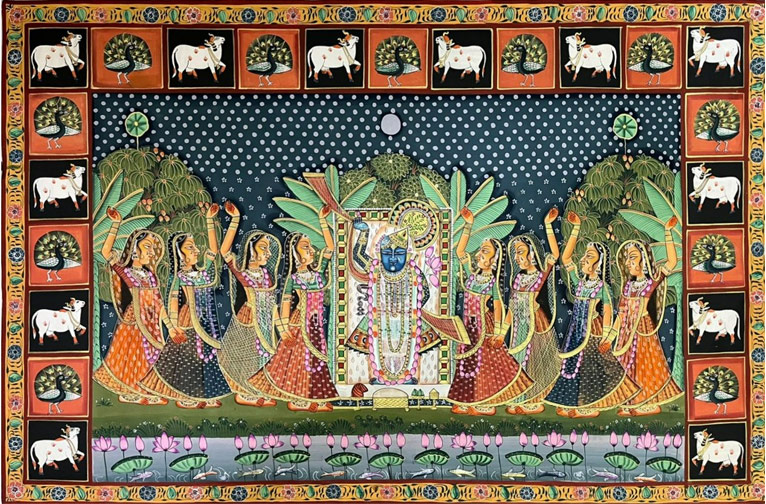Rajasthan’s’ stupendous artistic heritage offers visitors a mind-blowing experience regardless of which region you find yourself in. Each region has its specialty and of all of these four schools of painting stand out for their fantastic legacies; these are Mewar School, the Marwar School, The Kota-Bundi School, and the Jaipur-Amber Schools. Amongst the smaller ones, but of significance for their uniqueness are the Kishangarh, Ajmer, and Alwar schools. And who can ignore the charm of pichhwai, an art form which mushroomed around the Shrinatghji temple Temple at Nathdwara as a lively backdrop to lord Krishna the beloved deity in the sanctum.
While the chance discovery of Shekhawati’s haveli artworks shocked and delighted travellers way back in the 90’s, well ahead of that Bundi, Kota, and Kishangarh artistic renditions had been grabbing eyeballs for decades on end.
Bundi
The medieval city of Bundi came into its own as an art centre in the 17th century with its distinctive features. Amongst the oldest works during those formative years is the Bundi Ragamala from 1591 in the reign of Hada Rajput ruler Bhoj Singh. Ragamala or ‘Garland of Ragas’ is a series of visual depictions of the six musical melodies or ragas of Indian classical music. Ragamalas, which began trending in the 16th century 16th through the 19th centuries, are a recurring theme, as is the story of Krishna.
Two rulers were the driving forces of developing the Bundi School with their patronage. These were Rao Chattar Sal (1631–1659) and his son Rao Bhao Singh (1659–1682). In later years the tradition was further strengthened by his successors Aniruddha Singh (1682–1702) and Budh Singh. It was very fortuitous for Bundi that many of the rulers who followed were also great patrons of the arts.
Haul yourself up the slope Garh Palace, founded by Rao Raja Ratan Singh (1607–31) and expanded by subsequent rulers, to the famous Chitrashala, built by Raja Rao Umed Singh (1749–1771), Budh Singh’s son. The Chitrashala offers a wonderful treat of some of the best murals you’ll find in Bundi. What is remarkable about the paintings in the Chitrashala is the consummate artistry reflected in scenes from the Ragamala and episodes from much much-loved Radha-Krishna story.
Paintings from Raja Rao Umed Singh’s days were marked for their Deccani influence, evident in the profusive use of vibrant hues. Early days Mughal influence is mirrored in the imagery of nature in its many forms, (flora, fauna and avifauna, jungles, waterbodies, and the like) used with a lavish hand. Elephants were particularly popular. Baramasa is also a much-favoured subject for the Bundi muralist.
Dating from the reign of Ram Singh (1821–1889) the murals in the chitrashalain of the Bundi palace complex featured royal processions, hunting scenes, and vignettes from the life of Krishna. The Badal Mahal or Cloud Palace, Phool Mahal, and Chattar Mahal Palace here display paintings that are distinct from each other.
At Phool Sagar, you’ll find murals created by Italian prisoners of war who were held here; Sukh Nivas was host to Rudyard Kipling who got his inspiration for his iconic book Kim from the scenes depicted here.
Kota
Curled up on the banks of the Chambal River, Kota was once regarded as the hallmark of Rajput power and culture. At the Rao Madho Singh Museum awash with antique weaponry and period costumes, set your sights on the finest selection of the Kota School of paintings.
The Kota school of painting evolved as an independent entity after Mughal Emperor Jahangir separated it from its twin Bundi, both of which were part of the Bundi kingdom till 1625.
This distinction became more evident during the reign of Jagat Singh (1658–1683). While in the early days, the style of painters still mirrored the Bundi miniatures, by the time Raja Ram Singh I (1686–1708) came to the throne Kota’s muralists had broken away from their reliance on the Bundi muralists to expand their own repertoire of subjects. What is quite significant about the Kota muralists, as against the days of the rule of Umed Singh (1770–1819), is the obsession with hunting scenes, and the thrill of the chase, which they depicted with realistic detail and great finesse. The murals in Kota’s City Palace showcase traditional Kota artistry in the court scenes and the iconic hunting scenes.
Kishangarh
Amongst the most stylized forms of miniature paintings out of Rajasthan have been the works of art from Kishangarh. The Kishangarh style reflects a deep engagement with individualistic facial type and religious intensity. Under the patronage of Raja Man Singh in the mid–17thcentury artists were honing their skills at creating these sophisticated works marked for the refined features of both men and women.
Krishna Leela themes were much-favoured subjects for the works commissioned by the rulers of Kishangarh from the reign of Raj Singh (1706–1748) who was deeply influenced by the Pushtimargiya cult of Vallabhacarya. Of interest is the turn in the mid-18th century, during the reign of poet-ruler Sawant Singh when the paintings of the women began reflecting pre-Mughal Hindu styles with the depicted of sharp features and highly exaggerated, curving eyes. A devout member of the Vallabhacarya sect Sawant Singh is best remembered for commissioning the brilliant series of paintings on the Radha–Krishna theme. Bani Thani or the Lady of Fashion, one of the most iconic paintings from the Kishangarh school, is rumoured to be inspired by Sawant Singh’s love for a singer who worked for his stepmother. The singer is considered to be a model for the typical Kishangarh facial type.


Your study of Rajasthani art heritage has a massive canvas to explore…Every trip you make to this wondrous region do make it a point to capture some new aspects of its dalliance with many new styles of paintings.